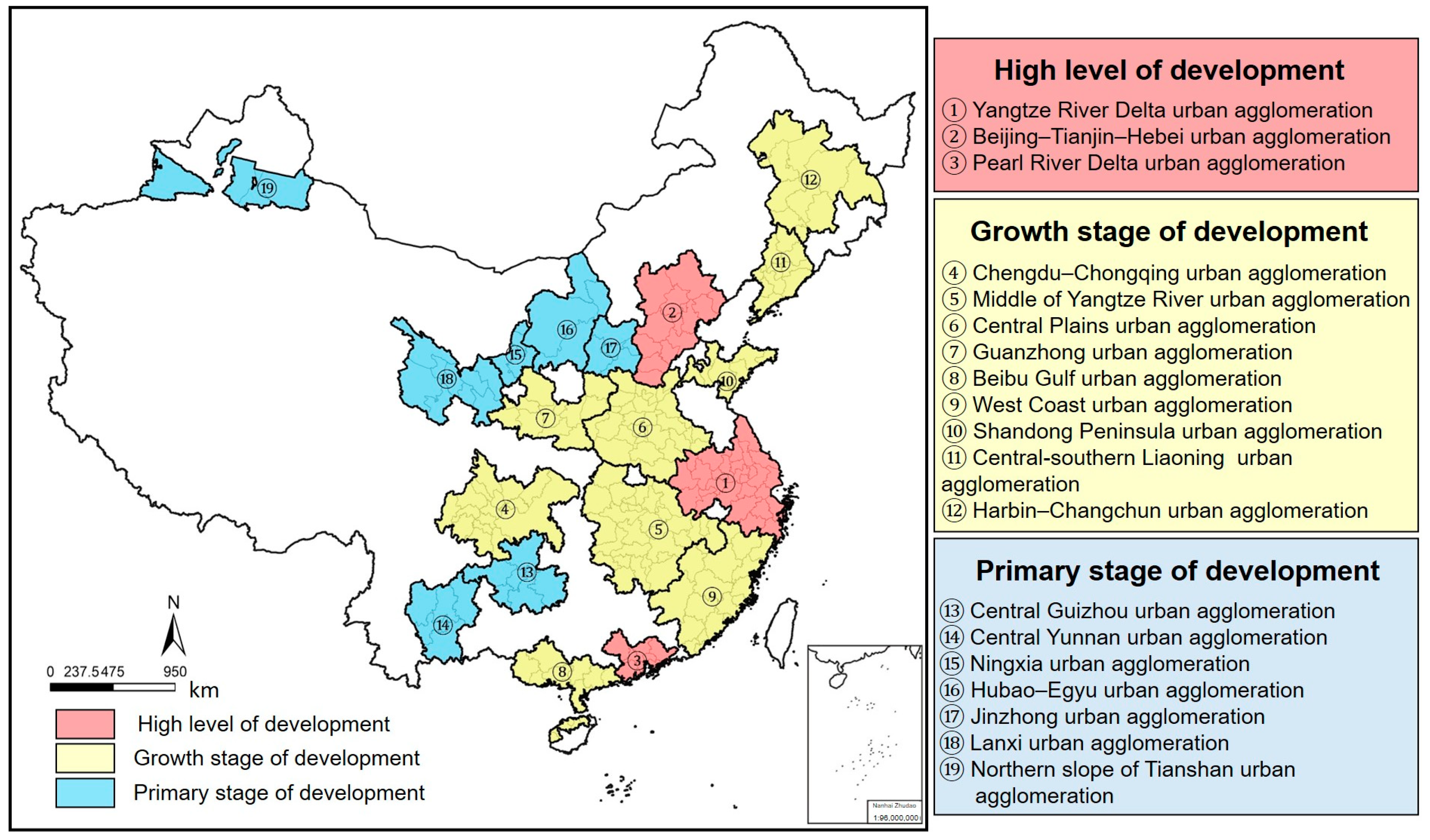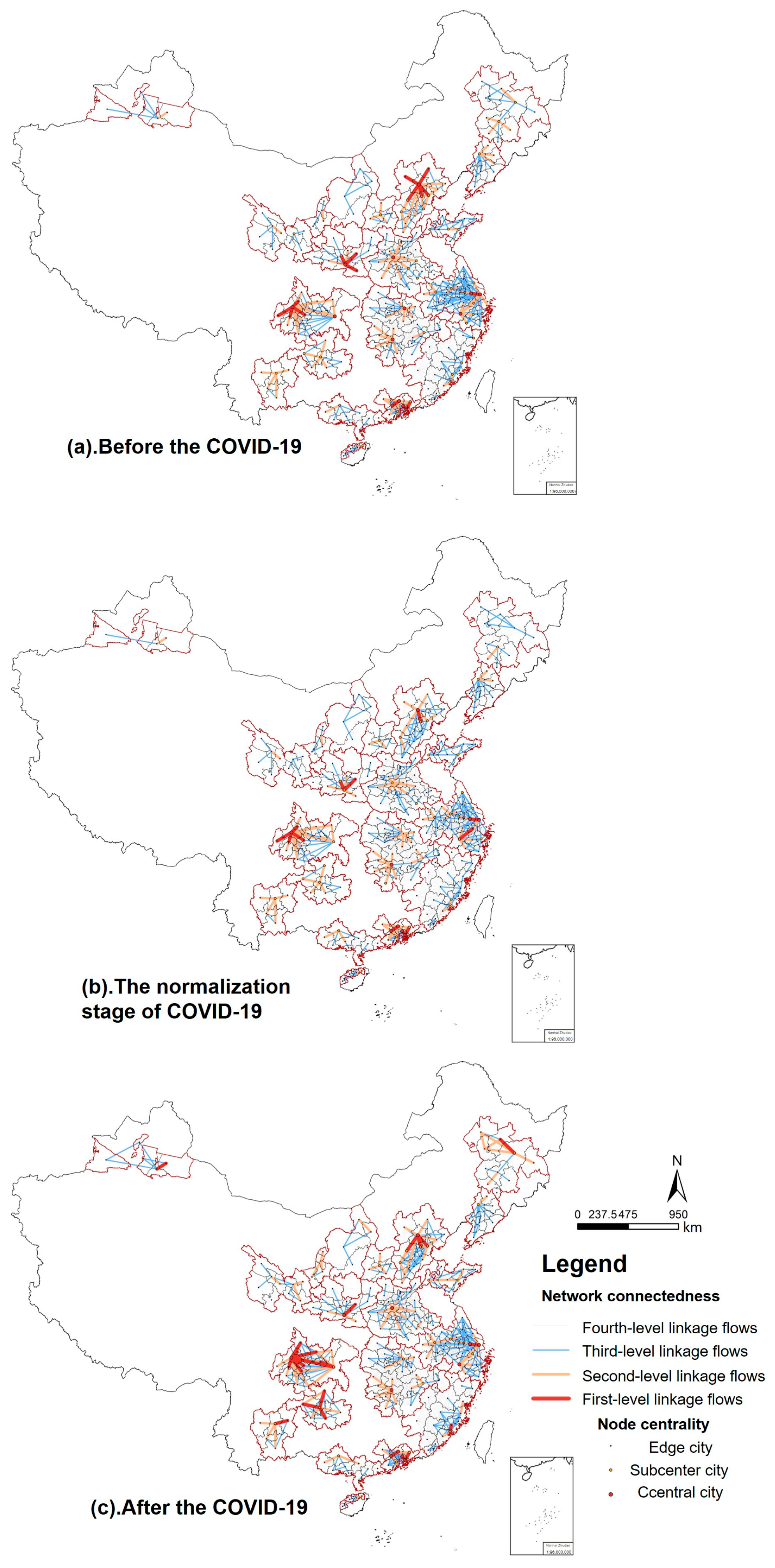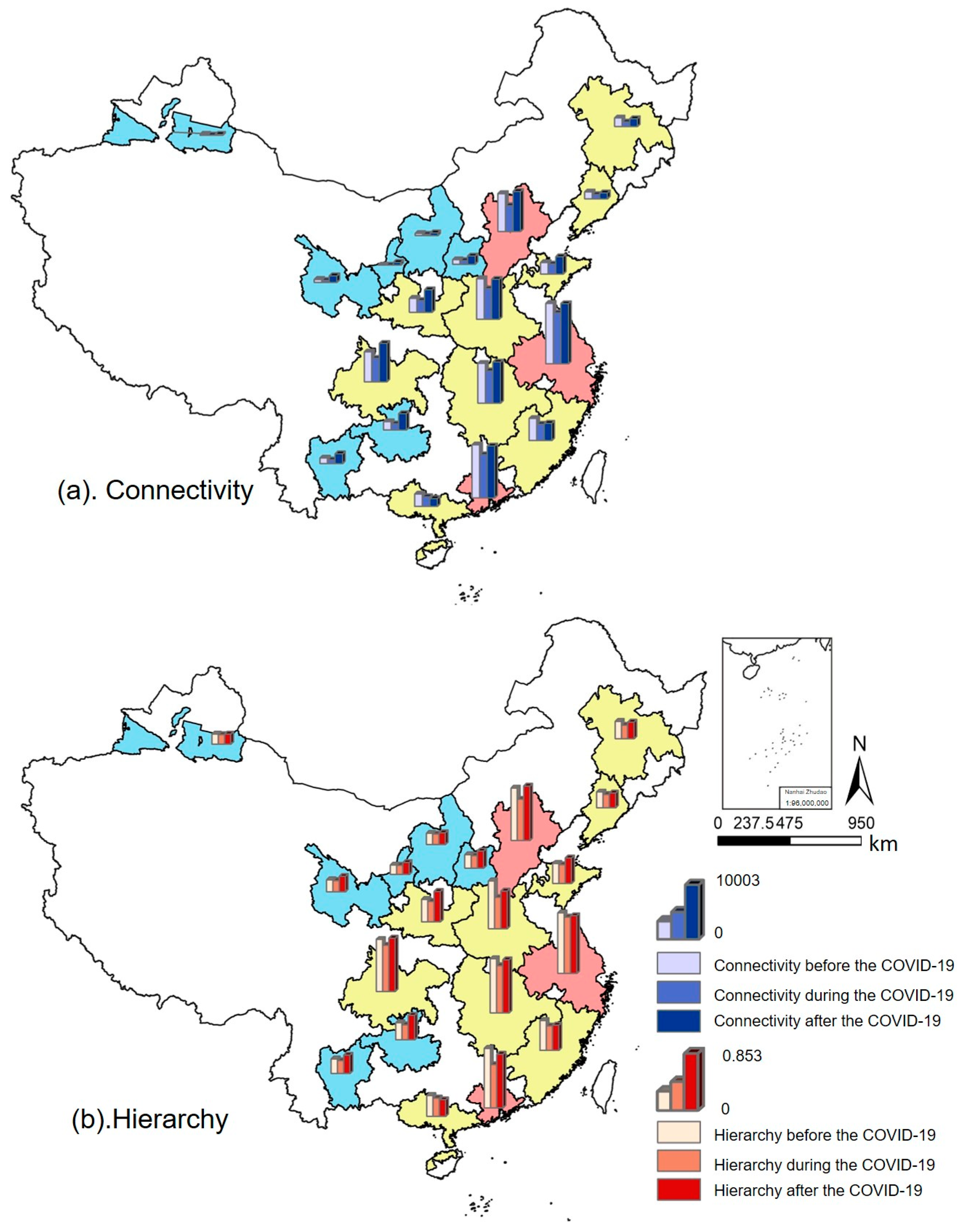Network Structure Characteristics and Influencing Factors of Urban Agglomerations in China under Impact of COVID-19
Abstract
:1. Introduction
2. Materials and Methods
2.1. Study Area
2.2. Data Sources and Processing
- (1)
- Baidu Migration Big Data
- (2)
- Urban basic data
2.3. Methodology
2.3.1. Social Network Analysis (SNA)
- (1)
- Calculation of the strength of network connectedness
- (2)
- Calculation of network density
- (3)
- Calculation of node centrality
- (4)
- Calculation of network connectivity
- (5)
- Calculation of network hierarchy
2.3.2. Methodology for Analyzing Impact Factors
2.3.3. Research Framework Graph
3. Results
3.1. Spatial Correlation Network of UAs in the Context of COVID-19
3.2. Characteristics of the Network Structure of UAs in the Context of COVID-19
3.3. Influencing Factor Analysis of the Network Structure of UAs in the Context of COVID-19
3.3.1. Selection of Factors Influencing the Network Structure of UAs in the Context of COVID-19
3.3.2. QAP Correlation Analysis
3.3.3. QAP Regression Analysis
4. Discussion
4.1. Discussion of the Characteristics of the Network Structures of Different Types of UAs
4.1.1. Discussion of Methodological Implications of the Research
4.1.2. Impact of COVID-19 on the Overall UA Network Structure
4.1.3. Impact of COVID-19 on the Network Structure of UAs with a High Level of Development
4.1.4. Impact of COVID-19 on the Network Structure of UAs in the Growth Stage of Development
4.1.5. Impact of COVID-19 on the Network Structure of UAs in the Primary Stage of Development
4.2. Policy Promotion Strategy
4.2.1. Foster Scientific and Rational Evolution of UA Network Structures
4.2.2. Upgrading the Economic Development of UAs
4.2.3. Enhance the Quality of Medical Services
4.2.4. Promoting the Integration of UAs
4.3. Limitations and Future Work
5. Conclusions
Author Contributions
Funding
Data Availability Statement
Conflicts of Interest
References
- Fang, C.; Cui, X.; Li, G.; Bao, C.; Wang, Z.; Ma, H.; Sun, S.; Liu, H.; Luo, K.; Ren, Y. Modeling regional sustainable development scenarios using the Urbanization and Eco-environment Coupler: Case study of Beijing-Tianjin-Hebei urban agglomeration, China. Sci. Total Environ. 2019, 689, 820–830. [Google Scholar] [CrossRef] [PubMed]
- Qiao, W.; Huang, X. The impact of land urbanization on ecosystem health in the Yangtze River Delta urban agglomerations, China. Cities 2022, 130, 103981. [Google Scholar] [CrossRef]
- Wu, J.; Huang, Y.; Jiang, W. Spatial matching and value transfer assessment of ecosystem services supply and demand in urban agglomerations: A case study of the Guangdong-Hong Kong-Macao Greater Bay area in China. J. Clean. Prod. 2022, 375, 134081. [Google Scholar] [CrossRef]
- Lin, S.; Chen, Z.; He, Z. Rapid Transportation and Green Technology Innovation in Cities—From the View of the Industrial Collaborative Agglomeration. Appl. Sci. 2021, 11, 8110. [Google Scholar] [CrossRef]
- Zhong, C.; Arisona, S.M.; Huang, X.; Batty, M.; Schmitt, G. Detecting the dynamics of urban structure through spatial network analysis. Int. J. Geogr. Inf. Sci. 2014, 28, 2178–2199. [Google Scholar] [CrossRef]
- Weladee, S.; Sanit, P. The Spatial Distribution of Taxi Stations in Bangkok. Sustainability 2023, 15, 14080. [Google Scholar] [CrossRef]
- Lasota, M.; Zabielska, A.; Jacyna, M.; Gołębiowski, P.; Żochowska, R.; Wasiak, M. Method for Delivery Planning in Urban Areas with Environmental Aspects. Sustainability 2024, 16, 1571. [Google Scholar] [CrossRef]
- Fang, C. Important progress and future direction of studies on China’s urban agglomerations. J. Geogr. Sci. 2015, 25, 1003–1024. [Google Scholar] [CrossRef]
- Yue, M.; Ma, S. LSTM-Based Transformer for Transfer Passenger Flow Forecasting between Transportation Integrated Hubs in Urban Agglomeration. Appl. Sci. 2023, 13, 637. [Google Scholar] [CrossRef]
- Keil, R.; Ali, H. Governing the sick city: Urban governance in the age of emerging infectious disease. Antipode 2007, 39, 846–873. [Google Scholar] [CrossRef]
- Das, D.; Zhang, J.J. Pandemic in a smart city: Singapore’s COVID-19 management through technology & society. Urban Geogr. 2021, 42, 408–416. [Google Scholar]
- Mandavilli, A. SARS epidemic unmasks age-old quarantine conundrum. Nat. Med. 2003, 9, 487. [Google Scholar] [CrossRef] [PubMed]
- Jia, J.S.; Lu, X.; Yuan, Y.; Xu, G.; Jia, J.; Christakis, N.A. Population flow drives spatio-temporal distribution of COVID-19 in China. Nature 2020, 582, 389–394. [Google Scholar] [CrossRef]
- Batty, M. The New Science of Cities; MIT Press: Cambridge, MA, USA, 2013. [Google Scholar]
- Stouffer, S.A. Intervening Opportunities: A Theory Relating Mobility and Distance. Am. Sociol. Rev. 1940, 5, 845–867. [Google Scholar] [CrossRef]
- Rogerson, P.A. Parameter estimation in the intervening opportunities model. Geogr. Anal. 1986, 18, 357–360. [Google Scholar] [CrossRef]
- Jiang, X.; Wei, W.; Wang, S.; Zhang, T.; Lu, C. Effects of COVID-19 on urban population flow in China. Int. J. Environ. Res. Public Health 2021, 18, 1617. [Google Scholar] [CrossRef] [PubMed]
- Mu, X.; Fang, C.; Yang, Z.; Guo, X. Impact of the COVID-19 epidemic on population mobility networks in the Beijing–Tianjin–Hebei urban agglomeration from a resilience perspective. Land 2022, 11, 675. [Google Scholar] [CrossRef]
- Zhang, W.; Chong, Z.; Li, X.; Nie, G. Spatial patterns and determinant factors of population flow networks in China: Analysis on Tencent Location Big Data. Cities 2020, 99, 102640. [Google Scholar] [CrossRef]
- Wang, Y.; Sun, Q.; Yang, S.; Pei, R.; Xiao, G.; Liu, B. Human factors analysis and risk assessment during the spread of the Covid-19 epidemic: A case study of the 2019 Wuhan outbreak in China. Hum. Ecol. Risk Assess. Int. J. 2022, 28, 1124–1145. [Google Scholar] [CrossRef]
- Yang, H.; Zhai, G.; Zhang, Y. Ecological vulnerability assessment and spatial pattern optimization of resource-based cities: A case study of Huaibei City, China. Hum. Ecol. Risk Assess. Int. J. 2021, 27, 606–625. [Google Scholar] [CrossRef]
- Luan, X.; Xiang, P.; Jia, F. The Interconnectivity and Spatio-Temporal Evolution of Rail Transit Network Based on Multi-Element Flows: A Case Study of Beijing-Tianjin-Hebei Urban Agglomeration, China. Land 2024, 13, 249. [Google Scholar] [CrossRef]
- Yang, M.; Zhai, G. Measurement and Influencing Factors of Economic Resilience over a Long Duration of COVID-19: A Case Study of the Yangtze River Delta, China. Land 2024, 13, 175. [Google Scholar] [CrossRef]
- Castells, M. The Informational City: Information Technology, Economic Restructuring, and the Urban-Regional Process; Blackwell Oxford: Hoboken, NJ, USA, 1989; Volume 1. [Google Scholar]
- de Vries, J.J.; Nijkamp, P.; Rietveld, P. Exponential or Power Distance-Decay for Commuting? An Alternative Specification. Environ. Plan. A Econ. Space 2009, 41, 461–480. [Google Scholar] [CrossRef]
- Zhong, Y.; Chen, Y.; Qiu, J. Study on the Spatial Structure of the Complex Network of Population Migration in the Poyang Lake Urban Agglomeration. Sustainability 2023, 15, 14789. [Google Scholar] [CrossRef]
- Brashears, M.E. Exponential Random Graph Models for Social Networks: Theory, Methods, and Applications. Contemp. Sociol. 2014, 43, 552–553. [Google Scholar] [CrossRef]
- Jiang, X.; Wang, S. Research on China’s urban population mobility network: Based on Baidu migration big data. Chin. J. Popul. Sci. 2017, 2, 35–46. [Google Scholar]
- Liu, H.; Wang, L.; Li, Q.; Yan, C. Spatial and temporal patterns of city connection networks in the Yellow River Basin based on Tencent’s big data of population migration. Econ. Geogr. 2020, 40, 28–37. [Google Scholar]
- Wu, K.; Li, C.; Liu, J.; Hao, H. Identification of growth boundary of core areas in an urban agglomeration based on spatial syntax theory. Geogr. Res. 2020, 39, 1418–1426. [Google Scholar] [CrossRef]
- Liang, Z.; Huang, J.; Wei, F.; Shen, J.; Li, S. Identifying the spatial range of urban agglomerations in China based on night light remote sensing and POI data. Geogr. Res 2020, 39, 92–102. [Google Scholar]
- Lu, Z.; Li, W.; Zhou, S. Constructing a resilient ecological network by considering source stability in the largest Chinese urban agglomeration. J. Environ. Manag. 2023, 328, 116989. [Google Scholar] [CrossRef]
- Li, H.; Hu, X.-B.; Guo, X.; Liu, H. An improved model considering traditional network properties to assess spatial vulnerability of a network system. Hum. Ecol. Risk Assess. Int. J. 2017, 23, 519–533. [Google Scholar] [CrossRef]
- Liu, H.; Zhou, L.; Tang, D. Exploring the impact of urbanization on ecological quality in the middle reaches of the Yangtze River Urban Agglomerations, China. Hum. Ecol. Risk Assess. Int. J. 2023, 29, 1276–1298. [Google Scholar] [CrossRef]
- Lu, Y.; Zhai, G.; Zhou, S.; Shi, Y. Risk reduction through urban spatial resilience: A theoretical framework. Hum. Ecol. Risk Assess. Int. J. 2021, 27, 921–937. [Google Scholar] [CrossRef]
- Liu, D.; Wang, Y.; Wang, L.; Xu, L.; Chen, H.; Ma, Y. Analysis of Spatiotemporal Changes in the Gravitational Structure of Urban Agglomerations in Northern and Southern Xinjiang Based on a Gravitational Model. Land 2024, 13, 29. [Google Scholar] [CrossRef]
- Porat, I.; Benguigui, L. Global migration topology analysis and modeling of directed flow network 2006–2010. Phys. A Stat. Mech. Its Appl. 2021, 561, 125210. [Google Scholar] [CrossRef]
- Krackardt, D. QAP partialling as a test of spuriousness. Soc. Netw. 1987, 9, 171–186. [Google Scholar] [CrossRef]
- Butts, C.T. Social network analysis: A methodological introduction. Asian J. Soc. Psychol. 2008, 11, 13–41. [Google Scholar] [CrossRef]
- Rank, O.N. Formal structures and informal networks: Structural analysis in organizations. Scand. J. Manag. 2008, 24, 145–161. [Google Scholar] [CrossRef]
- Feng, X.; Pan, C.; Xu, F. The Spatial Structure and Influencing Factors of the Tourism Economic Network in the Yangtze River Delta Urban Agglomeration. Tour. Hosp. 2024, 5, 60–79. [Google Scholar] [CrossRef]
- De Montis, A.; Barthélemy, M.; Chessa, A.; Vespignani, A. The structure of interurban traffic: A weighted network analysis. Environ. Plan. B Plan. Des. 2007, 34, 905–924. [Google Scholar] [CrossRef]
- Colizza, V.; Barrat, A.; Barthélemy, M.; Vespignani, A. The role of the airline transportation network in the prediction and predictability of global epidemics. Proc. Natl. Acad. Sci. USA 2006, 103, 2015–2020. [Google Scholar] [CrossRef] [PubMed]
- Xu, J.; Li, A.; Li, D.; Liu, Y.; Du, Y.; Pei, T.; Ma, T.; Zhou, C. Difference of urban development in China from the perspective of passenger transport around Spring Festival. Appl. Geogr. 2017, 87, 85–96. [Google Scholar] [CrossRef]
- Wang, C.; Yan, J. An inversion of the constitution of the Baidu migration scale index. Dianzi Keji Daxue Xuebao/J. Univ. Electron. Sci. Technol. China 2021, 50, 616–626. [Google Scholar]
- Zeyu, X.; Mian, Y. Impacts of Fighting COVID-19 on China’s Population Flows: An Empirical Study Based on Baidu Migration Big Data. Popul. Res. 2020, 44, 74–88. [Google Scholar]
- Zhang, C.; Li, Y.; Xiong, S.; Lu, X.; Zhu, X. Regional environmental risk assessment and management guide for rapid urbanization process of a city cluster in China. Hum. Ecol. Risk Assess. Int. J. 2016, 22, 283–301. [Google Scholar] [CrossRef]
- Fang, C.; Mao, Q.; Ni, P. The Controversy and Exploration of Scientific Selection and Grading Development of Chinese Urban Agglomeration. J. Geogr 2015, 70, 515–527. [Google Scholar]
- Chen, S.; Zhou, R.; Gao, J. Spatial-temporal characteristics of population flow during Spring Festival travel rush in Yangtze River Delta urban agglomeration based on Tencent migration data. Hum. Geogr. 2020, 35, 130–138. [Google Scholar]






| UA | Before COVID-19 | The Normalization Stage of COVID-19 | After COVID-19 | |||
|---|---|---|---|---|---|---|
| Connectivity | Hierarchy | Connectivity | Hierarchy | Connectivity | Hierarchy | |
| ① | 10,003 | 0.853 | 8524 | 0.794 | 9963 | 0.814 |
| ② | 6447 | 0.838 | 4563 | 0.581 | 6796 | 0.797 |
| ③ | 8845 | 0.837 | 7305 | 0.609 | 8655 | 0.785 |
| ④ | 6187 | 0.733 | 5188 | 0.649 | 6529 | 0.749 |
| ⑤ | 6254 | 0.763 | 5577 | 0.665 | 6348 | 0.746 |
| ⑥ | 5879 | 0.674 | 4317 | 0.443 | 5984 | 0.532 |
| ⑦ | 2711 | 0.316 | 2371 | 0.288 | 2651 | 0.308 |
| ⑧ | 2438 | 0.294 | 2020 | 0.259 | 2131 | 0.265 |
| ⑨ | 3970 | 0.421 | 3060 | 0.345 | 3204 | 0.357 |
| ⑩ | 2298 | 0.282 | 2085 | 0.264 | 2220 | 0.279 |
| ⑪ | 1595 | 0.224 | 1186 | 0.189 | 1436 | 0.212 |
| ⑫ | 1863 | 0.246 | 1218 | 0.192 | 1741 | 0.236 |
| ⑬ | 1816 | 0.242 | 1487 | 0.214 | 3073 | 0.347 |
| ⑭ | 1364 | 0.204 | 1079 | 0.181 | 2022 | 0.259 |
| ⑮ | 528 | 0.134 | 494 | 0.132 | 950 | 0.172 |
| ⑯ | 955 | 0.171 | 824 | 0.159 | 1531 | 0.218 |
| ⑰ | 837 | 0.162 | 710 | 0.152 | 935 | 0.168 |
| ⑱ | 1204 | 0.191 | 1064 | 0.179 | 1801 | 0.241 |
| ⑲ | 645 | 0.144 | 546 | 0.136 | 654 | 0.145 |
| Influencing Factors | Variables | Description of Variables |
|---|---|---|
| Economic Development Level | Gross Domestic Product (GDP) (XGDP) | Matrix of differences in GDP |
| Medical Facility Capacity | Physicians per 10,000 population (XMP) | Matrix of differences in physicians per 10,000 population |
| Transportation Infrastructure Capacity | Miles of city roads (XTM) | Matrix of differences in miles of city roads |
| Spatial Proximity | Geographic distance from city to city (XS) | Matrix of differences in geographic distance |
| Number of cross-province links (XK) | 0 for inter-province links, 1 for cross-province links | |
| Innovation Accessibility | University education per 10,000 population (XG) | Matrix of differences in university education per 10,000 population |
Disclaimer/Publisher’s Note: The statements, opinions and data contained in all publications are solely those of the individual author(s) and contributor(s) and not of MDPI and/or the editor(s). MDPI and/or the editor(s) disclaim responsibility for any injury to people or property resulting from any ideas, methods, instructions or products referred to in the content. |
© 2024 by the authors. Licensee MDPI, Basel, Switzerland. This article is an open access article distributed under the terms and conditions of the Creative Commons Attribution (CC BY) license (https://creativecommons.org/licenses/by/4.0/).
Share and Cite
Wu, J.; Xu, L.; Shi, Y.; Lu, Z.; Ma, Q. Network Structure Characteristics and Influencing Factors of Urban Agglomerations in China under Impact of COVID-19. Appl. Sci. 2024, 14, 4368. https://doi.org/10.3390/app14114368
Wu J, Xu L, Shi Y, Lu Z, Ma Q. Network Structure Characteristics and Influencing Factors of Urban Agglomerations in China under Impact of COVID-19. Applied Sciences. 2024; 14(11):4368. https://doi.org/10.3390/app14114368
Chicago/Turabian StyleWu, Jinxian, Lihua Xu, Yijun Shi, Zhangwei Lu, and Qiwei Ma. 2024. "Network Structure Characteristics and Influencing Factors of Urban Agglomerations in China under Impact of COVID-19" Applied Sciences 14, no. 11: 4368. https://doi.org/10.3390/app14114368







